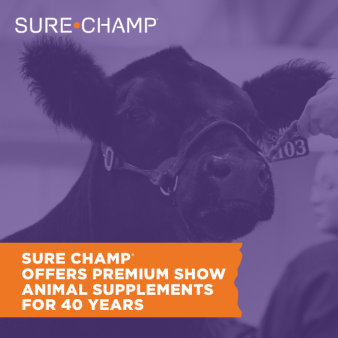
Caring for show livestock in the winter definitely has its advantages. Hair typically grows better. You don’t have to wait until late at night to turn out due to the heat. Flies are not a nuisance. However, there is a small, wingless creature that can have a significant impact on cattle, sheep, goats and pigs if it is not prevented – lice.
These insects can wreak havoc on your livestock herds and flocks and cause significant financial loss. Lice cause intense itching. Livestock will spend a tremendous amount of time rubbing and licking in an effort to relieve their discomfort. They spend so much time focused on rubbing and licking that it decreases their feed intake, feed efficiency, weight gain and growth. This lack of performance results in a significant financial loss for the enterprise.
Addressing Show Livestock Lice is Vital
Imagine the devastation that excessive rubbing and licking will cause from the itching in your show livestock. You have spent countless hours washing, brushing and working skin and hair. Losing hair due to a little pest like lice or mites on goats is the last thing you want to happen in the winter.
Lice live on the skin and in the hair of animals. Their life cycle is typically about a month long. Once lice and nymphs fall off of an animal, their survival rate is not very long since they need the skin/blood to survive. Adults feed for about a month, then lay eggs known as nits and die. Nits attach tightly to hair shafts, and eggs hatch in one to three weeks. Those nymphs metamorphose into adults.
Types of Livestock Lice
Depending on the livestock you have in your barn, there are various species of lice. However, lice are divided into two families: biting and sucking. Adult biting lice and nymphs eat dead skin cells, hair and other debris found on the skin. Adult sucking lice and nymphs penetrate skin and consume blood. Sucking lice can cause anemia in very young animals.
Both sucking and biting lice can impact various livestock species. See Table 1.
Livestock Lice Treatment
Not all livestock lice treatments are created equally. However, the most important thing to remember is to double up on your treatments. Treat all adults and nymphs on your livestock with an initial treatment. Then, three weeks later, follow up with a second application to treat any new nymphs and adults that have hatched since the initial treatment. You will likely find this two-step approach to livestock lice treatment incredibly effective for saying goodbe to lice populations on your animals.
Remember, lice are transmitted from animal to animal. It is important to treat every calf, lamb, goat or pig you have in the show barn at the same time. Otherwise, your treatments are probably not going to be super effective.
Recommended Treatments
Both topical and injectable treatments are recommended for livestock lice treatment. The most important things to remember are to 1) always read and follow the label, and 2) consider withdrawal times on any injectables.
Most insecticides, like Ivermectin and Dectomax, work to treat lice. Remember that injectable products will only kill sucking lice. The biting lice do not ingest blood, which is where the drug is contained. Pour-on dewormers are another effective treatment for lice. Clean-up contains an insect growth regulator (IGR), and it is great at breaking the lice lifecycle on cattle.
Keeping wool shorter will also help reduce lice infestations.
Care that Comes Full Circle
At BioZyme®, we strive to provide you with quality information so you can #preptowin. Typically, that comes through the valuable nutrition we provide your animals with products powered by AO-Biotics® Amaferm®. However, with this article, and others you will be reading in the future, we want to become your source for livestock information.
Depend on Sure Champ to #poweryourchampions. Depend on BioZyme to empower your knowledge.
Are you looking for further information on a specific show livestock topic? Drop an email to our Marketing Brand Manager with your question or idea for a blog topic.
Get Support from BioZyme Today
Interested in learning more about BioZyme products? Explore our online store today. Want to local dealer to purchase BioZyme products? Check out our Find a Dealer tool!
Sign Up for More Information
And if this blog was helpful to you, you may want to sign up for our regular newsletters. They’re a great source for regular helpful informational blogs and details on products and special deals.

